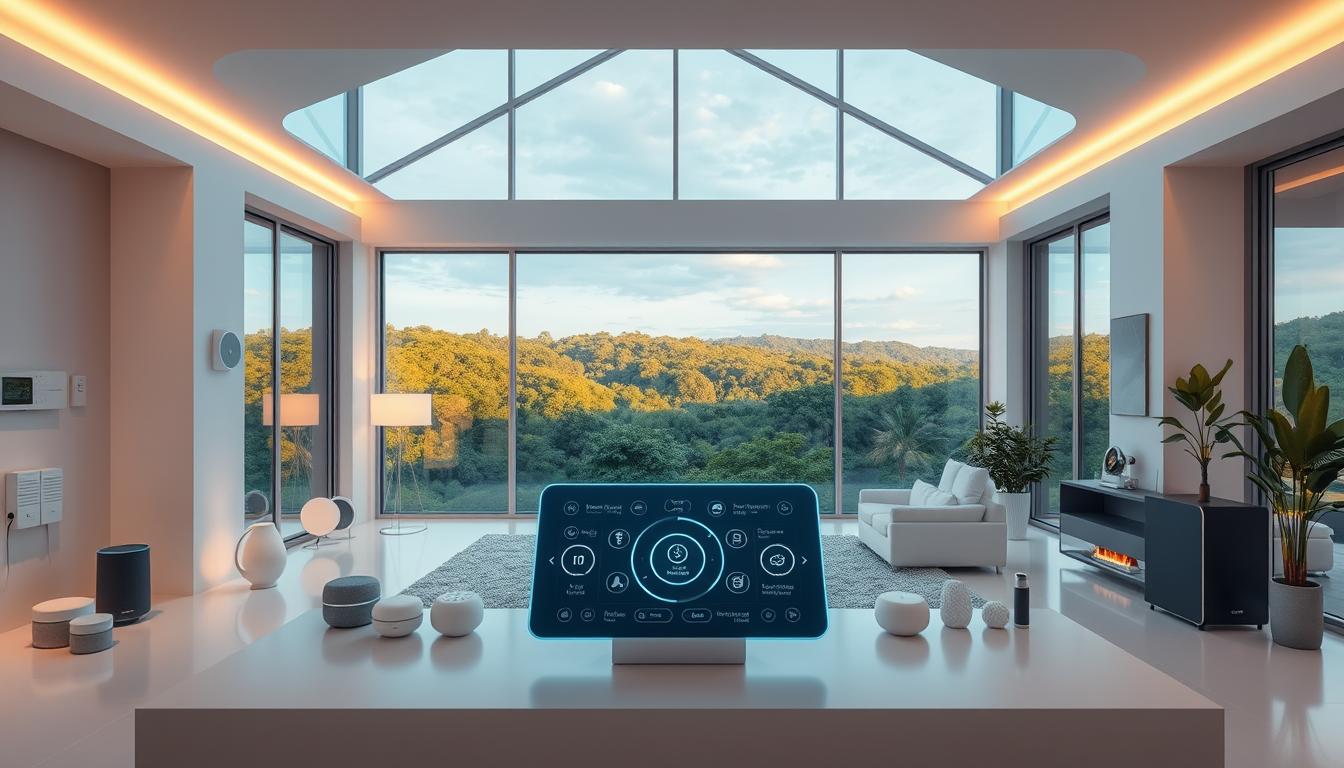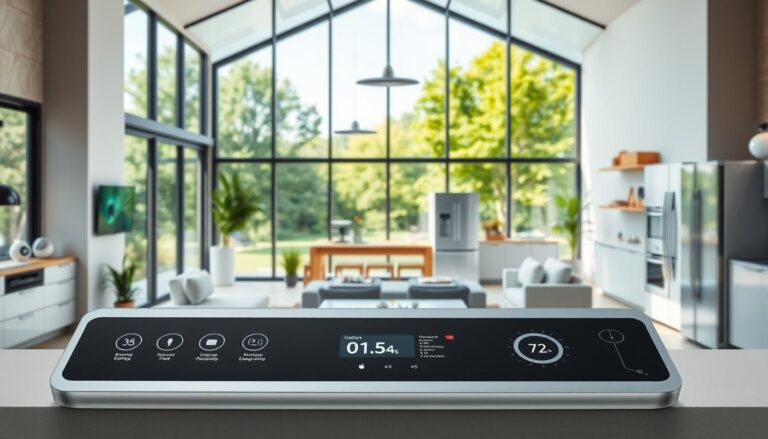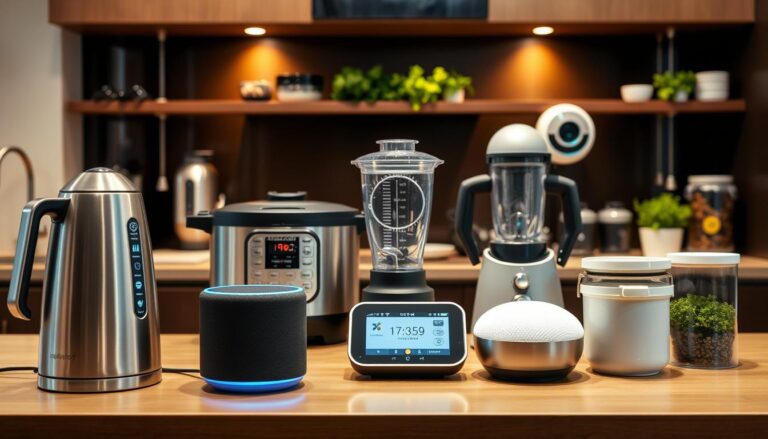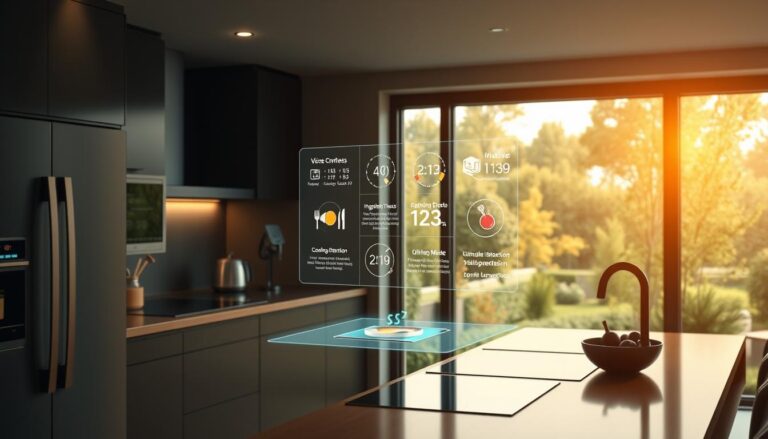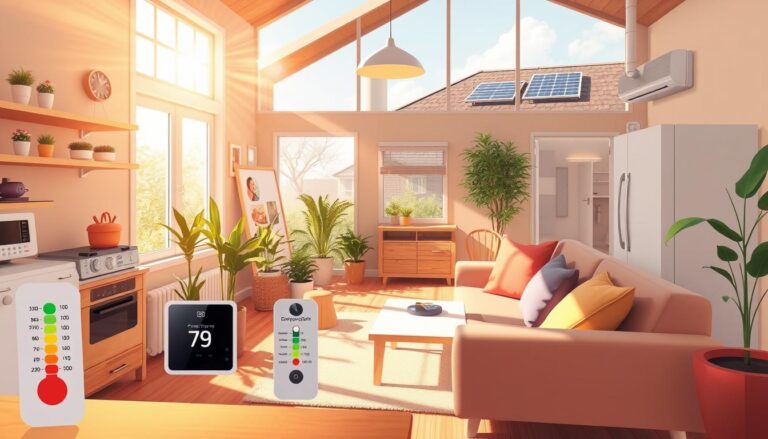Smart Home Automation: Transform Your Living Space
Imagine waking up to a house that knows your routine—lights that brighten as you rise, coffee brewing on its own, and doors that lock automatically. This is the power of smart home technology, a revolution in how we interact with our living spaces.
Connected devices like Nest thermostats and automated lighting systems bring unmatched convenience. They also help save energy, reducing costs while enhancing comfort. Whether it’s adjusting the temperature remotely or ensuring your home is secure, these innovations make life simpler.
Integrating these systems is easier than ever. With just a few steps, you can create a seamless ecosystem that works for you. From controlling appliances to managing security, smart home solutions offer efficiency and peace of mind.
Ready to explore how this technology can transform your space? Let’s dive into the details and discover the possibilities.
Key Takeaways
- Smart home devices bring convenience and energy savings.
- Automated systems like lighting and thermostats enhance daily living.
- Integration is simple, creating a connected ecosystem.
- Energy efficiency and comfort are key benefits.
- Security features provide peace of mind.
Introduction to Smart Home Concepts
From programmable thermostats to voice assistants, smart systems are redefining modern living. These innovations connect devices seamlessly, creating an ecosystem that enhances daily life. Whether it’s adjusting the temperature or monitoring your space, these technologies offer unmatched convenience.
Overview of Smart Homes
A smart home integrates various devices and systems to create a connected environment. These devices communicate through the Internet of Things (IoT), allowing for remote control and automation. For example, a thermostat can adjust itself based on your schedule, while lights can turn off when you leave the room.
Historically, early automation focused on simple tasks like timed lighting. Today, advanced systems manage everything from energy usage to security. This evolution has made smart homes more accessible and efficient.
The Rise of Connected Living Spaces
IoT devices have transformed how we interact with our spaces. Smart speakers like Amazon Alexa and Google Assistant allow voice control, while security cameras provide real-time monitoring. These technologies work together to create a cohesive experience.
One of the most critical aspects of a smart home is its security system. With features like remote surveillance and automated alarms, these systems ensure safety and peace of mind. Centralized security systems manage all connected devices, making it easier to monitor your space.
| Feature | Benefit |
|---|---|
| Programmable Thermostats | Energy savings and comfort |
| Voice Assistants | Hands-free control |
| Security Cameras | Real-time monitoring |
| Automated Lighting | Convenience and energy efficiency |
Connected living spaces have evolved significantly, offering both convenience and security. As technology advances, these systems will continue to shape how we live, making our spaces smarter and more efficient.
What is Home Automation?
Picture a living space where devices work together seamlessly, responding to your needs before you even ask. This is the essence of home automation—a system that schedules and triggers actions to simplify your daily life.
With automation, you can set your lights to turn on at sunset or adjust your thermostat when you leave for work. These scheduled actions save time and energy, making your space more efficient.
Rules and scenes take automation a step further. For example, a “Good Morning” scene can turn on the lights, start the coffee maker, and play your favorite playlist—all with a single command. These coordinated actions create a seamless experience.
Voice control and mobile apps are central to managing automation. Smart speakers like Amazon Alexa and Google Assistant let you control devices with just your voice. Mobile apps offer remote access, so you can manage your space from anywhere.
Automation also enhances home security. Smart locks and security cameras can be programmed to alert you of unusual activity. For instance, if a door opens unexpectedly, you’ll receive a notification on your phone. This added layer of security provides peace of mind.
Understanding the basics of automation sets the stage for creating a connected, efficient living space. From voice commands to security features, these systems transform how you interact with your environment.
Benefits of Integrating Smart Home Devices
Transforming your living space with smart devices offers unmatched convenience and efficiency. These systems simplify daily tasks while enhancing comfort and security. Whether it’s adjusting your lighting or monitoring your space, the advantages are clear.
Convenience and Efficiency
Smart devices like voice control assistants and security cameras make life easier. Imagine turning off your lights with a simple command or checking your space remotely. These features save time and effort, streamlining your routine.
For example, smart lighting systems adjust based on the time of day. They brighten at sunrise and dim at sunset, creating a natural rhythm. This not only enhances comfort but also reduces energy waste.
Cost Savings on Energy and Utilities
One of the biggest perks is the potential for cost savings. Smart thermostats and plugs optimize energy usage, cutting down on utility bills. Studies show these systems can reduce energy consumption by 10-30%.
Programmable thermostats adjust temperatures based on your schedule. This ensures your space is comfortable when you’re there and energy-efficient when you’re not. Smart plugs can turn off devices automatically, preventing standby power drain.
By integrating these technologies, you’ll enjoy both convenience and economic benefits. It’s a win-win for your lifestyle and your wallet.
Enhancing Home Security with Smart Technology
Your living space can now be a fortress of safety with smart technology. From cameras to alarm systems, these devices offer advanced protection and peace of mind. They’re designed to keep you connected and in control, no matter where you are.
Remote Surveillance and Alarm Systems
Smart cameras provide constant monitoring, even when you’re away. Brands like Ring and Nest offer high-definition video feeds with night vision and motion detection. These features ensure you never miss a thing—whether it’s a delivery or an unexpected visitor.
Alarm systems take security a step further. They integrate seamlessly with smart home devices, sending real-time alerts to your phone. For example, if a door opens unexpectedly, you’ll know immediately. This instant notification helps you act quickly, keeping your space secure.
Energy efficiency is another benefit. Many security devices use low-power protocols, ensuring they don’t drain resources. This balance of safety and sustainability makes smart technology a smart choice for modern living.
Remote Control and Voice Assistance
Control your living space with just your voice or a tap on your phone—welcome to the era of remote control and voice assistance. These technologies make managing your space effortless, whether you’re adjusting the lights, locking the door, or setting the thermostat.
Smart Speakers and Mobile Control
Smart speakers like Amazon Echo and Google Nest act as central hubs for your connected devices. They allow you to control everything from lighting to security with simple voice commands. Mobile apps complement these speakers, offering remote access to your space from anywhere.
For example, you can turn off the lights or check if the door is locked while you’re away. This combination of voice and mobile control ensures you’re always in charge, no matter where you are.
Comparing Alexa, Google Assistant, and Siri
Each voice assistant brings unique features to the table. Alexa excels in device compatibility, offering seamless integration with a wide range of smart devices. Google Assistant shines with its natural language processing, making interactions feel more conversational.
Siri, on the other hand, integrates deeply with Apple’s ecosystem, providing a smooth experience for iPhone and Mac users. Here’s a quick comparison:
- Alexa: Best for device compatibility and third-party skills.
- Google Assistant: Superior in understanding natural language and context.
- Siri: Ideal for Apple users, offering seamless integration with iOS devices.
Choosing the right assistant depends on your needs and existing devices. Each platform offers a unique user experience, ensuring you find the perfect fit for your lifestyle.
Key Components of a Smart Home System
At the heart of every connected space lies a system of essential components working in harmony. These elements ensure seamless communication between devices, making your space smarter and more efficient. From central hubs to connectivity protocols, each piece plays a vital role in creating a cohesive experience.
Central Hubs and Connectivity Protocols
Central hubs act as the brain of your smart system. Devices like Amazon Echo and Google Nest Hub connect various technologies, allowing them to work together. These hubs use protocols like WiFi, ZigBee, and Z-Wave to ensure smooth communication.
WiFi is the most common protocol, offering fast and reliable connections. ZigBee and Z-Wave, on the other hand, are designed for low-power devices, making them ideal for sensors and smart plugs. Each protocol has its strengths, ensuring compatibility with a wide range of devices.
Mobile apps are another critical component. They let you control your system from your phone, offering convenience and flexibility. Whether you’re adjusting the thermostat or checking security cameras, these apps put control at your fingertips.
Here’s a quick breakdown of common connectivity protocols:
- WiFi: High-speed, ideal for streaming and heavy data usage.
- ZigBee: Low-power, perfect for sensors and smart lighting.
- Z-Wave: Reliable, designed for security systems and locks.
Understanding these components helps you build a system that works for your needs. From central hubs to mobile apps, each piece contributes to a smarter, more connected space.
Understanding IoT and its Role in Home Automation
The Internet of Things (IoT) is reshaping how we interact with everyday devices, making them smarter and more connected. IoT refers to a network of physical objects embedded with sensors, software, and other technologies to exchange data over the internet. In the context of smart living, IoT enables devices to communicate and work together, creating a seamless experience for the person.
IoT Devices Overview
Common IoT devices include smart thermostats, lighting systems, and security cameras. These home devices are designed to simplify daily tasks and enhance comfort. For example, a smart thermostat adjusts the temperature based on your schedule, while smart lighting can dim or brighten according to the time of day.
Voice assistants like Alexa and Google Assistant play a crucial role in coordinating these devices. They act as central hubs, allowing you to control multiple devices with simple voice commands. This integration makes managing your space effortless and intuitive.
Interconnected Communication Protocols
IoT devices rely on communication protocols to exchange data. Common protocols include WiFi, ZigBee, and Z-Wave. WiFi offers high-speed connectivity, ideal for streaming and heavy data usage. ZigBee and Z-Wave are low-power options, perfect for sensors and smart lighting.
These protocols ensure that devices can communicate reliably, even in complex setups. Standardized protocols are essential for creating a cohesive system that responds quickly and efficiently to your needs.
| Protocol | Use Case |
|---|---|
| WiFi | High-speed, ideal for streaming and data-heavy devices |
| ZigBee | Low-power, perfect for sensors and smart lighting |
| Z-Wave | Reliable, designed for security systems and locks |
Interconnectivity enhances the functionality of IoT devices, making them more responsive and efficient. Whether it’s adjusting the thermostat or monitoring security, IoT technology ensures your space works for you.
Smart Lighting and Energy Efficiency
Step into a world where your lights adapt to your mood and schedule, creating the perfect ambiance effortlessly. Smart lighting isn’t just about brightness—it’s about transforming your space into a dynamic, energy-efficient environment.
With features like color customization, dimming, and scheduling, these systems offer both style and savings. Imagine setting your lights to warm tones for a cozy evening or bright white for a productive work session. It’s all possible with a few taps on your phone or a simple voice command.
Smart Bulbs, Scheduling, and Dimming Solutions
Smart bulbs are the cornerstone of modern lighting. Brands like Philips Hue and LIFX offer bulbs that can change colors, dim, and even sync with your music or movies. Scheduling ensures your lights turn on and off automatically, saving energy when you’re not around.
Dimming controls add another layer of flexibility. Adjust the brightness to match the time of day or your activity. For example, dimmed lights in the evening can help you unwind, while brighter settings are perfect for morning routines.
Voice assistants like Alexa and Google Assistant make controlling your lights even easier. Pair them with a speaker, and you can adjust your lighting with simple commands. Companion apps also allow remote control, so you can manage your lights from anywhere.
Here’s why smart lighting is a game-changer:
- Energy Efficiency: Smart bulbs use up to 80% less energy than traditional incandescent bulbs.
- Cost Savings: Reduced energy consumption translates to lower utility bills.
- Customization: Tailor your lighting to match your mood or activity.
- Convenience: Control your lights with your voice or phone.
Leading company names like Philips, LIFX, and Sengled are driving innovation in the smart lighting market. They’re introducing features like motion sensors, advanced scheduling, and integration with other smart devices. This continuous evolution ensures your lighting system stays cutting-edge.
Smart lighting isn’t just a trend—it’s a smart investment in comfort, efficiency, and sustainability. Whether you’re looking to enhance your space or reduce your energy footprint, these systems deliver on all fronts.
Innovative Smart Appliances for Every Room
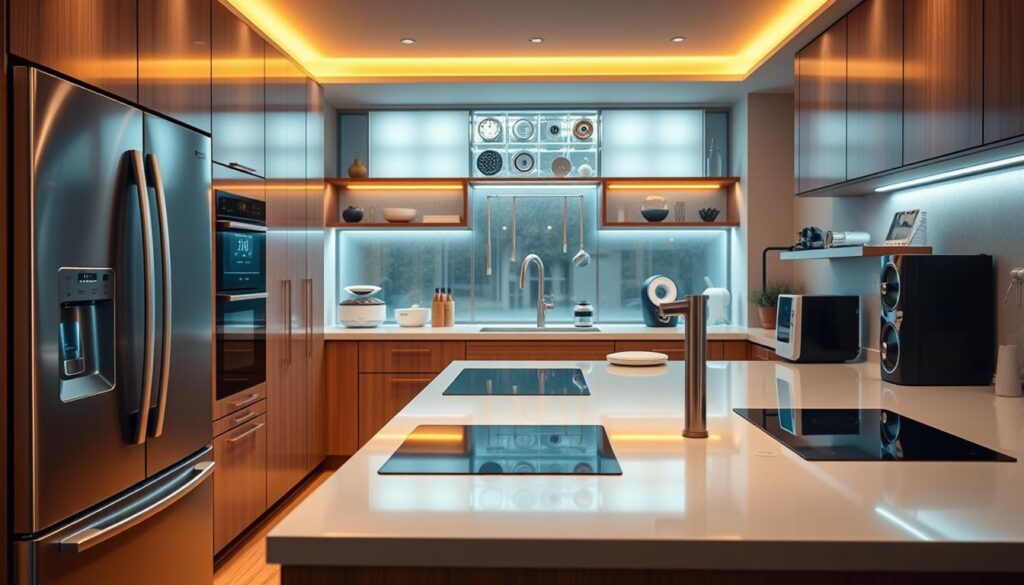
Your daily routine gets a tech upgrade with appliances that think ahead. From the kitchen to the laundry room, these devices are designed to make life easier and more efficient. By integrating with your network, they create a seamless experience that adapts to your needs.
Smart appliances use advanced sensors to enhance functionality. For example, a smart refrigerator can notify you when food is about to spoil. It can even suggest recipes based on what’s inside. These features save time and reduce waste, making your space more efficient.
In the kitchen, smart ovens and coffee makers are changing the game. Imagine preheating your oven with a voice command or brewing your favorite coffee from bed. These appliances connect to your internet, allowing remote control and customization. It’s convenience at your fingertips.
Beyond the kitchen, smart devices like washing machines and air purifiers are equally impressive. They adjust settings based on load size or air quality, optimizing performance. With a strong network, these appliances work together to create a cohesive, efficient environment.
Here’s why smart appliances are a must-have:
- Convenience: Control devices remotely with your phone or voice.
- Efficiency: Sensors and smart protocols reduce energy and resource waste.
- Integration: Networked devices work together for a seamless experience.
Brands like Samsung, LG, and Bosch are leading the charge with innovative designs. Their appliances are not just tools—they’re intelligent assistants that adapt to your lifestyle. Whether it’s a smart dishwasher or a connected air purifier, these devices are transforming how we live.
At the heart of these innovations is the internet. It enables devices to communicate, learn, and improve over time. This connectivity ensures your appliances are always up-to-date and working at their best.
Smart appliances are more than a trend—they’re a smart investment in efficiency and convenience. By integrating them into your space, you’re creating a smarter, more connected environment that works for you.
Smart Devices in the Living Room: Entertainment and Convenience
Your living room can become the ultimate hub for entertainment and security with smart devices. These technologies bring together comfort, control, and cutting-edge innovation, transforming your space into a seamless experience.
Smart Speakers and Displays
Smart speakers like Amazon Echo and Google Nest act as the central hub for your connected devices. They allow you to control everything from lighting to security with simple voice commands. Displays like the Nest Hub add visual interaction, showing weather updates, video feeds, or even recipes.
These devices are designed to enhance convenience. For example, you can adjust the thermostat or play your favorite playlist without lifting a finger. The integration of voice assistants ensures a hands-free experience, making your living room smarter and more efficient.
Security Cameras and Sensors
Security cameras and sensors add an extra layer of safety to your living space. Brands like Ring and Arlo offer high-definition cameras with motion detection and night vision. These features ensure you’re always aware of what’s happening, even when you’re away.
Sensors, like door and window alarms, work seamlessly with your hub to provide real-time alerts. If a door opens unexpectedly, you’ll receive a notification on your phone. This instant feedback helps you act quickly, keeping your space secure.
Here’s a quick comparison of popular devices:
| Device | Feature | Cost |
|---|---|---|
| Amazon Echo | Voice control, Alexa integration | $99 |
| Google Nest Hub | Display, Google Assistant | $89 |
| Ring Camera | Motion detection, night vision | $199 |
| Arlo Sensor | Door/window monitoring | $49 |
These devices strike a balance between cost, quality, and technological sophistication. Whether you’re looking to enhance entertainment or improve security, smart living room devices deliver on all fronts.
By integrating these technologies, you’re creating a space that works for you. From voice-controlled speakers to advanced security systems, your living room becomes a smarter, more connected environment.
Connected Kitchen for Modern Cooking
Step into a kitchen where technology simplifies every meal, from prep to cleanup. Smart devices are transforming how we cook, clean, and enjoy our meals. These innovations bring efficiency, convenience, and a touch of luxury to your culinary space.
Smart Ovens, Refrigerators, and Cooking Appliances
Smart ovens and refrigerators are at the heart of a connected kitchen. These appliances use advanced sensors to adjust cooking times, monitor food freshness, and even suggest recipes. For example, a smart oven can scan a QR code on a frozen meal and cook it perfectly without any guesswork.
Smart refrigerators take convenience to the next level. They track expiration dates, create grocery lists, and even let you view their contents remotely via a mobile application. This feature ensures you never forget an ingredient again.
Voice-Controlled Recipe Assistance
Voice assistants like Alexa and Google Assistant are revolutionizing how we cook. Simply ask for a recipe, and your assistant will guide you step-by-step. Some devices even adjust cooking settings automatically, ensuring perfect results every time.
This hands-free approach is perfect for busy cooks. It allows you to focus on the task at hand while your assistant handles the details. Plus, it’s a great way to discover new recipes and techniques.
Automated Coffee Makers and Robot Vacuums
Start your day with a perfectly brewed cup of coffee from an automated coffee maker. These devices can be programmed to brew at specific times or controlled remotely via a mobile application. Some even integrate with voice assistants for hands-free operation.
Robot vacuums are another game-changer for kitchen upkeep. They keep your floors clean without any effort on your part. Some models even map your kitchen layout for more efficient cleaning. These devices are perfect for busy households or those with pets.
| Device | Feature | Benefit |
|---|---|---|
| Smart Oven | QR code scanning | Perfect cooking every time |
| Smart Refrigerator | Remote viewing | Never forget an ingredient |
| Voice Assistant | Recipe guidance | Hands-free cooking |
| Robot Vacuum | Kitchen mapping | Efficient cleaning |
Privacy is a top priority for smart kitchen devices. Manufacturers ensure that your data is secure and that devices comply with strict privacy standards. This allows you to enjoy the benefits of technology without worrying about your information.
By integrating these devices, you’re creating a kitchen that works for you. From voice-controlled recipes to automated cleaning, these innovations save time and enhance your cooking experience. It’s a smart investment in efficiency and convenience.
Improving Sleep and Bedroom Comfort with Smart Tech
Transform your bedroom into a sanctuary of rest with cutting-edge smart technology. These devices are designed to enhance your sleep quality, ensuring you wake up refreshed and ready to tackle the day. From adjusting room temperature to tracking your sleep patterns, smart tech offers personalized solutions for a better night’s rest.
Smart Beds and Sleep Trackers
Smart beds are revolutionizing the way we sleep. These advanced appliances adjust firmness based on your preferences, ensuring optimal support throughout the night. Some models even track your sleep stages, heart rate, and breathing patterns, providing detailed insights into your sleep quality.
Sleep trackers, like those from Fitbit or Withings, offer similar benefits. They monitor your movements and provide personalized recommendations to improve your sleep habits. By analyzing your data, these devices help you understand what’s affecting your rest and how to make adjustments.
Temperature and Air Quality Solutions
Maintaining the right environment is crucial for restorative sleep. Smart thermostats, like the Nest Learning Thermostat, automatically adjust the temperature to keep your bedroom between 60-67°F—the ideal range for sleep. Pair this with a smart humidifier or dehumidifier, and you’ll maintain optimal humidity levels, reducing allergens and improving air quality.
Smart air purifiers, such as those from Dyson, remove airborne pollutants that can disrupt sleep. These devices ensure you’re breathing clean air, which is essential for a restful night. By integrating these solutions, you’re creating a bedroom environment that supports your well-being.
Here’s how smart bedroom tech can improve your life:
- Personalized Comfort: Adjust your bed’s firmness and room temperature to suit your needs.
- Detailed Insights: Track your sleep patterns and receive actionable recommendations.
- Improved Air Quality: Remove allergens and pollutants for better breathing.
- Energy Efficiency: Smart devices optimize power usage, reducing energy waste.
By integrating these technologies, you’re investing in your health and quality of life. Whether it’s a smart bed, thermostat, or air purifier, these devices work together to create a bedroom that’s tailored to your needs. Start optimizing your sleep environment today and experience the difference smart tech can make.
Installation and Customization of Smart Home Devices
Setting up smart devices can be as simple as a few taps or as detailed as a professional installation. Whether you’re a tech enthusiast or prefer expert help, understanding your options ensures a smooth experience. Let’s explore the differences between DIY and professional setups, their benefits, and how to choose the right method for your needs.
DIY Setup vs. Professional Installation
DIY installation is ideal for those comfortable with technology. It allows you to control the process and save on labor costs. Many devices come with step-by-step guides, making it easy to set up in a day. However, it requires a certain level of technical skill and patience.
Professional installation, on the other hand, offers expertise and peace of mind. Technicians handle everything from wiring to integration, ensuring optimal performance. This option is perfect for complex systems or those who prefer a hands-off approach. While it’s more expensive, it often includes warranties and ongoing support.
Both methods have their pros and cons. DIY is cost-effective and flexible, while professional services provide reliability and expertise. Consider your technical level and the complexity of your system before deciding.
Cloud-Based Systems and Customization
Cloud-based systems simplify device management and updates. They allow you to control your devices remotely, making adjustments from anywhere. This is especially useful for busy schedules or when you’re away for the day.
Customization is another key benefit. Whether it’s setting up schedules or creating personalized scenes, smart devices adapt to your lifestyle. For example, you can program lights to turn on at sunset or adjust the thermostat when you leave for work. These features enhance convenience and efficiency.
Here are some tips for customization:
- Start small: Begin with basic devices like smart bulbs or plugs.
- Use apps: Most devices come with companion apps for easy control.
- Experiment: Try different settings to find what works best for you.
Cost Implications and Savings
DIY setups are generally more affordable, with costs ranging from $100 to $3,000. Professional installations, however, can cost significantly more, depending on the system’s complexity. For example, HVAC control systems can range from $2,000 to $10,000.
Despite the higher upfront cost, professional services often provide long-term value. They ensure proper installation, reducing the risk of malfunctions. Additionally, warranties and support offer added security.
Here’s a quick cost comparison:
| Installation Type | Cost Range |
|---|---|
| DIY | $100 – $3,000 |
| Professional | $500 – $10,000+ |
Choosing the right installation method depends on your budget, technical level, and needs. Whether you go DIY or professional, smart devices can transform your space into a connected, efficient environment.
Tips for a Secure and Efficient Smart Home Network
Keeping your smart devices secure is essential for protecting your family and maintaining privacy. With the rise of IoT, it’s crucial to implement best practices that safeguard your network and data. Let’s explore how you can achieve this balance between convenience and security.
Best Practices for IoT Security and Privacy
Start by regularly updating your devices’ firmware. Studies show that use of updated software can reduce vulnerabilities by up to 70%. This simple step ensures your devices are protected against the latest threats.
Next, create strong, unique passwords for each device. Avoid common phrases or easily guessable combinations. A password manager can help you keep track of these credentials securely.
Enable two-factor authentication (2FA) wherever possible. This adds an extra layer of security, making it harder for unauthorized users to access your network. It’s a small effort that can make a big difference.
Finally, segment your network. Keep your family’s personal devices on a separate network from your IoT devices. This limits the potential damage if one device is compromised.
Safeguarding Privacy Across Connected Devices
Privacy is just as important as security. Review the privacy settings on each device to control what data is shared. For example, disable unnecessary data collection features that could expose your cooking habits or daily routines.
Consider using a virtual private network (VPN) to encrypt your internet traffic. This is especially useful when accessing your smart devices remotely. It ensures your data remains private, even on public networks.
Be cautious about third-party apps and integrations. Only download apps from trusted sources and verify their permissions. Some apps may request access to more data than they need, putting your privacy at risk.
Balancing Convenience and Security
While smart devices offer incredible convenience, it’s important not to compromise on security. For example, voice assistants can simplify tasks like setting timers while cooking, but ensure they’re configured to only respond to authorized voices.
Regularly audit your devices and their settings. Remove any that you no longer use or that pose a security risk. This keeps your network streamlined and secure.
By following these tips, you can enjoy the benefits of a connected space while keeping your family and data safe. A secure smart network is the foundation of a truly efficient and enjoyable experience.
Future Trends in Home Automation and IoT

The future of connected living is evolving faster than ever, with innovations that promise to redefine how we interact with our spaces. From smarter devices to enhanced security, the next wave of technology is set to transform our daily lives. Let’s explore what’s on the horizon for IoT and connected systems.
Predictions and Upcoming Innovations
Experts predict that the IoT market will grow exponentially, with over 75 billion devices connected by 2025. This surge will bring advancements in safety, energy efficiency, and user experience. For instance, biometric authentication in security systems is expected to rise by 40%, offering unparalleled protection.
One of the most exciting trends is the integration of AI. By 2025, AI-driven systems could reduce energy consumption by up to 30%. This means smarter thermostats, lighting, and appliances that adapt to your habits while saving resources. It’s not just about convenience—it’s about sustainability.
In the lighting category, expect innovations like adaptive bulbs that sync with your circadian rhythm. These devices will adjust brightness and color temperature to improve sleep and productivity. Combined with motion sensors, they’ll ensure energy is used only when needed.
“The future of IoT lies in seamless integration and personalized experiences. Devices will not only respond to commands but anticipate needs, creating a truly intuitive environment.”
Security systems are also set to become more sophisticated. Enhanced protocols will protect against cyber threats, while real-time monitoring will offer peace of mind. For example, smart cameras with AI can distinguish between familiar faces and potential intruders, reducing false alarms.
Here’s a quick look at what’s coming:
- AI Integration: Devices that learn and adapt to your preferences.
- Energy Efficiency: Systems that optimize resource usage.
- Enhanced Safety: Advanced protocols and biometric authentication.
- Smart Lighting: Adaptive bulbs that improve well-being.
These trends are not just about technology—they’re about improving quality of life. By embracing these innovations, you’ll create a space that’s safer, more efficient, and tailored to your needs. The future of connected living is here, and it’s brighter than ever.
Conclusion
The integration of smart technologies offers a lot of benefits, transforming how we live and interact with our spaces. From energy-efficient thermostats to advanced security systems, these innovations enhance convenience while saving resources. Voice-controlled devices and mobile apps make managing your environment effortless, whether you’re adjusting lighting or monitoring your property remotely.
Energy efficiency is a standout advantage, with smart systems reducing consumption by up to 30%. Enhanced security features, like real-time alerts and biometric authentication, provide peace of mind. The growing market for these technologies reflects their increasing popularity, with projections reaching $174 billion by 2025.
Adopting smart solutions not only improves daily life but also adds long-term value to your space. Explore the market to find devices that suit your needs and start enjoying the lot of benefits they bring. Embrace the future of connected living today.
FAQ
What is a smart home?
How does home automation improve energy efficiency?
Are smart home systems secure?
Can I control smart devices without a hub?
What are the best voice assistants for smart homes?
How do smart appliances enhance modern cooking?
What are the benefits of smart lighting?
Can I install smart home devices myself?
What is the role of IoT in smart homes?
What future trends can we expect in home automation?
Source Links
- 31 Home Automation Ideas: Transform Your Living Space
- RMSInstalls
- Transform Your Living Space with Home Automation
- What is a Smart Home? Everything You Need to Know|Definition from TechTarget
- Get Started With Smart Home Automation
- An Introduction to Home Automation Systems (Beginner Guide)
- What Is Home Automation and How Does It Work?
- Home automation
- 6 Advantages Of Smart Home Technology To Live A Better Life
- Exploring the Benefits of Smart Home Automation System Maintenance
- Integrating Smart Home Devices with Your Home Security System
- Enhancing Home Security with Smart Home Automation – Veritais
- Talking with Home Assistant – get your system up & running
- Josh.ai | AI Control for the Smart Home
- Smart Home: Definition, How They Work, Pros and Cons
- 13 Smart Home Features to Consider
- Smart Home Guide: Automate Your Space
- IoT and Home Automation: How Does it Work | Sam Solutions
- The power of IoT home automation | IoT Now News & Reports
- Save Energy with Smart Home Products
- Smart Lighting Systems & Home Automation
- Smart Home Automation and Energy Efficiency
- The Best Smart Home Devices for 2025
- 15 Smart Appliances Every High-Tech Home Needs | iRobot Blog
- 10 Smart Home Devices for Home Automation
- Upgrade Your Living Room With Smart Home Automation |
- Smart Living Room: Your Must-Haves | AV Smart Solutions
- Smart Kitchens: Revolutionizing Your Home with High-Tech Convenience – Decorilla Online Interior Design
- Smart Kitchens: Integrating Technology for a Connected Home – Kitchen Solvers
- A Smart Home Technology Guide for Kitchens…
- Can Smart Home Devices Improve Sleep? – Amerisleep
- Smart home wellness – Sleep habits, air quality, and more
- I Tested Smart Lights for Better Sleep and Here’s What Actually Worked
- Home Automation Installation: What You Need to Know
- Control4 Smart Homes
- Smart Home Cybersecurity Hubs: Protecting Endpoints in Your Smarthome
- Internet Bundle Now: Discover the Best Internet, TV & Mobile Deals Near You
- The Future of Home Automation: How IoT is Transforming Everyday Living – Conure
- Future developments in the smart home – Freedompro
- Simplify Your Life with Home Automation
- The Benefits Of Home Automation: Simplify Your Life

